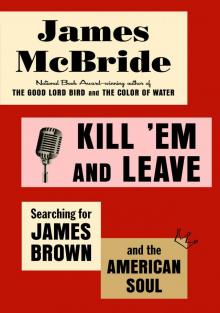- Home
- James McBride
Miracle at St. Anna (Movie Tie-in) Page 4
Miracle at St. Anna (Movie Tie-in) Read online
Page 4
“What the fuck you mean by that?”
“Look around you. You see anyone talkin’ on a radio? Our lines are cut. The battalion got out of Pietrasanta two hours ago. They was fighting with spoons and typewriters and pots and pans over there. I think they fell back to the other side of Valdicastello, or south toward Monteggiori. Who knows? The batteries in the wireless radio got wet and it’s out. Last I heard, the Germans were on it, anyway.”
The Germans had taken up positions on the other side of the canal. Stamps heard the German shout again, “Hey! You niggers come back and fix our wire.” He heard an American yell, “Tell your momma I’ll be right over.” He heard laughter from the American side, silenced by a single burst from a German eighty-eight, the shell swishing low, skimming across the canal and landing on the American side with a thunk as the Negroes scrambled. The shell was a dud. Now the Germans were laughing.
Stamps lay in the mud and watched Train as he moved higher and higher up the cliffs behind the Germans, a small dot on the side of the mountain. He thought he was dreaming. He’d known Train six months. Train was too dumb to do anything so stupid. “Goddamn,” he muttered. “That nigger’s lost his buttons.”
Bishop lay next to Stamps, watching too, and after a moment, he rose and began to walk downstream, looking for a place out of German range to cross.
“Where you going?” Stamps asked.
“Y’all go back if you want. The only person who’s got any luck around here is him. Plus, he owes me fourteen hundred dollars. That kind of money can set me up for the rest of my life. Even if the rest of my life is today.”
Stamps and Hector watched Bishop’s broad back as he crossed the creek, through the chest-high waters swirling around him. When he reached the German side, he trotted into the olive grove and began to climb the hill behind it that led to the Apuane Alps and, beyond them, the Serchio Valley.
After a moment, Hector and Stamps followed.
4
THE MOUNTAIN OF THE SLEEPING MAN
The American ground campaign in central Italy in December 1944 was unlike any other war fought in Europe during World War II. France had its rolling hills, its beautiful villages, its sweeping countryside where the enemy was easy to spot, its romantic Resistance fighters organized by General Marshall’s Americans. Germany had its snow and its black forests, its long, vacant tundras, where General Patton led his tanks and troops with cheering press correspondents A. J. Liebling and Ernie Pyle at his side. But in central Italy, the war was fought out of the public eye, at night, in winter, in cold, chaotic blackness, by Gurkhas, Italians, Brazilians, British, Africans, even Russian defectors, and most of all, by American Negroes, who were convinced that the white man was trying to kill them, in mountainous terrain where icy winter rains and high winds lashed the trees and bushes with hurricane force, pushing aside sanity and loosing all the ghosts and goblins of Italy’s past. The lovely mountains of Tuscany, mountains that would years later inspire dozens of gushing travel books from breathless American writers, were not friendly to the coloreds. They were rude and discourteous, dangerous and deadly. A single well-aimed artillery shot from a hidden German eighty-eight would land in the center of an advancing American company and leave several troops dead, scattering the rest. The fleeing soldiers would retreat in terror up the sides of mountains, where the muddy, choppy terrain seemed to reach out and grab their knees—to stretch the legs full length over the black slopes was impossible. With each stride, the ground rose up unevenly to meet their feet, and as they stumbled forward under ruthless German fire, the craggy slopes would suddenly pitch them into ditches that dropped ten feet or more, or the earth beneath their feet would end completely and the terrified soldier would find himself sprinting at top speed with nothing but air under his feet. Then, if he was wingless and faithful to God, he would drop three feet to crumple into a ravine; or if he was unlucky, he might plunge three hundred feet into solid stone or muddy, rocky earth that would collapse around him and bury him. The Negroes were terrified of the Tuscan mountains at night, even those who had been raised in America’s farm country, and with good reason, for even the Italians were afraid of them. Thirty years after the war, Italians in the Serchio Valley, near the towns of Barga, Gallicano, and Vergemoli, were still pulling skeletons of colored soldiers—some of them still locked in a death embrace with their German counterparts—from the ravines of the Tuscan mountains, and even then, three decades after the war, the Italians, tough mountain men and women themselves, didn’t want to touch the bodies, for those mountains held their secrets like the secrets of a young maiden’s heart, jealously and with great zeal, and to disturb that curious mixture of belief and denial was to invite trouble indeed. The Negro skeletons only added to the haunted legacy of mountains already full of five centuries of lore about wolves, witches, half-men and half-goats, child-gobbling goblins, woman-snatching moon monsters, angry cave fairies, toads that bit you and drained your life-blood, sleepwalking witches that entered rooms with rats crawling out of their mouths, and other creatures whose victims were found in the mountain’s muddy ridges: children who simply disappeared forever; farmers whose hair fell out and grew back like cotton days after they encountered an angry cave fairy; a village violinist expired after an argument with a half-man half-goat, the violinist found hanging from a tree by a violin string, his whistling violin still heard seventy years after he disappeared. The Italians of Tuscany were respectful of their beautiful, haunted peaks. They did not see them as mountains but as pieces of life, and as with all things familiar, they gave each a nickname: the Horse Mountain, the Table of the Thirsty Wizards, the Kingdom of Echo, the Laughing Witch Who Came Back, the Hill That Swallowed a City, and the most frightening of all, the Mountain of the Sleeping Man.
He is easy to see from any point in Barga and the surrounding Tuscan villages of the Serchio Valley. Even during the day, he is a frightening sight. He is huge. He lies on his back, his jaw extending with fury, his forehead huge and dense, with a crop of hair cut in Marine style jutting fiercely skyward. His angry, thick skull is topped by a colossal eyebrow furrowed in rage, his monstrous chest protrudes with mutinous strength, his steel-like legs bent at the knees knife skyward. Once you see him, you cannot escape him. He follows you everywhere you walk, morning, noon or night, his gargantuan face just over your shoulder—an enraged, snoozing ogre, about to awaken. Italian children were afraid to look at him. Shepherds crossed themselves when their herds wandered near his ridges. His shadow blocks the sunlight in the morning, and in afternoon the sun tiptoes across his gigantic brow so slowly that workers at the nearby Aracia iron mine often laughed that evenings never come to the Serchio Valley because the sun hasn’t the guts to slip any farther past the sleeping man’s brow lest it awaken him and be smacked clean into space.
The myth goes that he was a young shepherd who had fallen in love with a shepherdess long ago, but she was in love with a young sailor who was at sea. Despite his constant pleas and beautiful gifts, the maiden refused the shepherd’s entreaties and offer of marriage, so he vowed to wait until she changed her mind. He waited for years and years, but the young maiden never relented. She sat high in the mountains staring at the sea—so he lay on his back and stared at the sky, vowing to block her view of the sea until she changed her mind, angry that she would not acknowledge the love he so freely demonstrated. And there he lies to this day, sleeping, waiting, his huge chest blocking out the sun, his massive forehead nearly touching the moon, his thick hair crusted with snow, and most of all, those furious eyes which, from a distance, appear to be two eyes, but up close are only one eye and a true geological miracle: a huge oval encirclement of rock that rises up to the height of a five-story building. If he has the courage, a man can stand inside the sleeping giant’s eye, at the dead center of the circle, and gaze at the roofs of every village in the Serchio Valley below. And if he has the courage and listens closely, he can also hear the thunderous pounding of the giant’s angry broken heart.<
br />
It was within the sleeping giant’s eye that the German forces of Albert Kesselring’s 168th Panzer SS Division, among the most dreaded and fearsome warriors that ever walked the face of Europe, placed four regiments—fourteen thousand men in total—to plan a surprise attack on the exhausted and thinning ranks of American Negroes of the 92nd Buffalo Division, so named by the Native Americans who saw the first black cavalry as having hair akin to that of their beloved buffalo. And it was Kesselring’s forces that Colonel Jack Driscoll of the 92nd Division saw in a fuzzy aerial photograph in his intelligence report nine hours after the failed Cinquale Canal attack that separated Sam Train from reality and diced four companies of the 92nd into bits.
Driscoll sat outside his pup tent glaring at the photo and reading the intelligence report as roaring jeeps, growling tanks, and harried colored soldiers rushed all around him. Tall, slender, thirty, Boston-born, with a lean face and blue eyes that always held steady, Driscoll, his thin frame folded onto a crate, reached into his pocket and pulled out a cigarette, ignoring the bustle around him. What’s the point in hurrying now? he thought bitterly as he glanced at the soldiers and tanks hurrying past. All the fun’s over.
The Cinquale was a disaster, as he knew it would be. It was par for the course with the 92nd Division, where nothing ever went right. Someone had the bright idea that an end run could be made around the Ligurian Sea to avoid mines the Germans had placed from the coastal plains all the way up through the Apuane Alps and into the Serchio Valley. To try to take the canal without securing the high ground on the other side seemed such a stupid idea that Driscoll was surprised anyone would want to take credit for it, but he was there when General Parks, his superior by two ranks, had outlined the plan. Driscoll had no respect for Parks. The man had run a successful undertaker’s business before the war, and as far as Driscoll could tell, he was just ringing up future business. Now here they were, nine hours into the Cinquale Canal, and the jig was up. Fourteen tanks from the 597th and 598th field artillery units were all shot up. The beachhead was extended all of a thousand yards inland, thirty-three men were dead, 187 wounded, and the fuzzy aerial photograph in his lap showed at least a division-sized group of regiments sitting in place four miles away. It wasn’t possible. He didn’t believe the photo.
He lit the cigarette and carelessly tossed the match, which landed next to several barrels marked “fuel.” Ten pairs of Negro eyes watched him. He ignored them as he sucked in the smoke. Let it burn, he thought bitterly. The 92nd is going down in flames, and me with it, he thought. He watched as a Negro soldier walked over and stubbed out the burning match with his boot, then returned to a group that was standing at a tent across from Driscoll, staring. There was a time when ten Negroes staring at him would have made him nervous, but that was long ago. Driscoll smoked, ignoring them. He didn’t hate them like a lot of white commanders did. He didn’t even dislike them. He hated their trust in him. He turned his head back to the report, smoking silently and looking at the photo one more time. The inscription on the back said “11,000 feet.” That was all.
He stood up. He had to pass this on to the old man, General Allman, commander of the 92nd Division. Allman had been under a lot of pressure lately, and even though he was a tough old geezer, Driscoll was worried about him. A graduate of Virginia Military Institute, five feet two inches of steel-blue eyes and grit, Allman didn’t think coloreds were qualified to command, and he said it. He didn’t think many of the whites assigned to the division were up to the task either, and he said that, too. The coloreds hated him, and the second-rate white officers weren’t crazy about him either. His only son was missing in action in France; racial unrest, fights, shootings, and stabbings were tearing the division apart; and the big boys up in England and France had underestimated the Germans’ strength in Italy, which was why they were getting their asses kicked right now. Allman already knew the score on the canal, but he always wanted the gory details anyway, plus he needed to see this photograph. The photograph was muddy, a fake, Driscoll decided. Of unknown origin, possibly altered to appear British. No way would the Germans waste that amount of men and resources on this stretch of Italy. If they made a stand, it would be at La Spezia or at the Brenner Pass, near the Austrian border. But he’d let the general decide. That was his job.
As he rose, Driscoll noticed a lieutenant standing among those watching him. He had gone to a museum in Pisa on leave two weeks before and was surprised to find a group of Negroes from the division there admiring some of the paintings, this lieutenant among them. There was something in the man’s face Driscoll did not like. He called him over.
“What’s on your mind, Birdsong?”
“Um . . . Captain Nokes is interrogating a prisoner in regimental headquarters two, sir. Perhaps . . . perhaps you’d like to hear what he has to say.”
Driscoll frowned. The Negro division lived on rumors. The last one, about two colored soldiers hanged from trees outside Lucca for sleeping with an Italian prostitute, nearly caused a mutiny in one of the companies. He decided to nip this potential for rumor in the bud. “Let’s go,” he said.
He followed Birdsong to a large regimental tent. Standing inside was Captain Nokes, the white captain who had just transferred in, and a small Italian priest. Captain Nokes’s eyes widened when he saw Driscoll. He snapped to attention and saluted.
“What’s wrong?” Driscoll said.
“Nothing, sir. Just questioning this priest here.”
“You know Italian?”
“I can speak a few words, yes.”
Driscoll watched Birdsong shift uncomfortably.
“What’s he talking about?”
“Nothing,” Nokes said. “Well, a few things about where we can find some German prisoners is all. But nothing out of the ordinary.”
The priest was very young, with a large, brimmed hat and the flushed face of a drinker. He had no shoes. His collar was filthy, soot-black, and his face sweaty. He had the largest pair of ears that Driscoll had ever seen on any human being. He said something frantically. Driscoll had been raised in the Roman Catholic Church and knew Latin fairly well, but his Italian, he had to admit, was terrible.
He looked at Captain Nokes. “What does he want, food?”
“No. He said something about a church and a fight between the Germans and the Italian partisans. We’ll check it out, sir.”
Out of the corner of his eye, Driscoll saw Second Lieutenant Birdsong purse his lips, looking troubled. Driscoll turned to Birdsong.
“Didn’t I see you in Pisa at the museum two weeks ago, speaking Italian?”
“Yes, sir. I grew up in South Jersey with plenty of Italians. I also studied German in college.”
“What did this man say?”
Birdsong replied, “He said something about a large number of German paratroopers planning to come through the Serchio Valley in ten days or so. Around Christmas. Through the Lama di Sotto ridge.”
Driscoll straightened in alarm. The Lama di Sotto ridge was in the aerial photograph he had just seen. “How many Germans?” he asked.
“Two or three regiments.”
“Companies or regiments?”
“Regiments.”
“Ask him that again. Two or three companies or regiments?” A company was two hundred men. A regiment was four thousand.
Birdsong asked the question.
“Regiments, sir,” he said.
“Where’d he hear that?”
“From some Italians in his village and a German he saw here.”
“A German he saw here?”
Lieutenant Birdsong directed Driscoll’s question to the Italian, who responded.
“A German at the POW camp back at division headquarters,” Birdsong translated.
“There’s two hundred German prisoners there,” Driscoll said dryly.
“That’s what he said, sir.”
Captain Nokes shrugged. “It’s a lot of story there, sir.”
Driscoll ignored Nokes.
He had worked intelligence before. He had to consider the source. In his hand was a fuzzy photo taken from eleven thousand feet, of unknown origin. The man before him was a living source, a priest. Through Birdsong, he grilled the priest: Name. Birthplace. Parents’ names. Dates, when and where he’d served. Birdsong translated flawlessly.
After half an hour, Driscoll had heard enough. He turned to Captain Nokes. “Who’s your first lieutenant?”
“Huggs. He was killed this morning in the canal.”
Driscoll pointed to Birdsong. “This man speaks excellent Italian. How come he’s not a first lieutenant?” Nokes’s face took on the pallor of a man at a funeral. He was a short man with a downturned mouth, small, darting eyes, and lips the color of veal—a leather-skinned roughneck from Mississippi. The kind of officer, Driscoll noted wryly, that the division seemed constantly to attract, a reject and a transfer—somebody else’s problem.
Nokes barked, “In fact, I’ve been keeping my eye on this man, Colonel, and was about to promote him.” Driscoll was willing to wager a month’s pay that Nokes didn’t even know Birdsong’s name.
“Promote him now and have him take this priest down to the POW camp. Let him pick out the German he’s talking about. Then let him write up the S-2 intelligence report and have it to me by fifteen hundred hours.”
It seemed like too much information for Nokes to process, and as his face twisted and contorted with the effort, Driscoll silently cursed the Army policy that dictated that only Southerners were qualified to lead colored men. Nokes’s “Yes, sir” bounced off Driscoll’s back like a rubber ball, as Driscoll had already turned and left the tent.
He went to his tent and lay on his cot, troubled by what the priest had said. The information the priest offered was days old and probably useless. It was not corroborated other than by the photo, the veracity of which he still doubted. Still, the whole business bothered him. It had to be checked out right away, even though nothing could be done about it. The colored division was spread too thin as it was, fifteen thousand men over a thirty-mile front five miles wide, with the Germans fighting from concrete bunkers that were impervious to small-arms fire, and a huge railroad gun in La Spezia that was kicking the shit out of them. The Germans, ingenious fighters that they were, had placed a ship’s 406-millimeter cannon on a flatbed car, secured it, and wheeled it into a railroad tunnel. Anytime they wanted to, they rolled the cannon out, fired it, then wheeled it back in. The giant beast wreaked havoc, hurling shells weighing 560 pounds for thirty-eight miles. American bombers could not reach it. They needed a ship to float into the harbor and knock that goddamn thing out. But naval support cost money. Money meant politics. And politics, for a colored division? In Italy, which was poor and not strategically important? With the Negro press kicking their ass about the segregated Army’s treatment of coloreds, and good white boys dying in Normandy under Patton and Marshall? With General Allman, who had the guts to tell his superiors what he really thought, who was about as politically correct as General MacArthur? Forget it. The gun stayed, and it kicked the shit out of them. One single goddamn gun, he thought bitterly.

 Miracle at St. Anna
Miracle at St. Anna The Good Lord Bird
The Good Lord Bird Song Yet Sung
Song Yet Sung The Color of Water
The Color of Water Kill 'Em and Leave
Kill 'Em and Leave Deacon King Kong
Deacon King Kong Miracle at St. Anna (Movie Tie-in)
Miracle at St. Anna (Movie Tie-in)